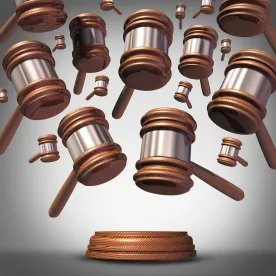In a decision that likely will reverberate throughout the administrative state, a three-judge panel of the United States Court of Appeals for the Fifth Circuit recently held in Jarkesy v. Securities and Exchange Commission1 that the Securities and Exchange Commission’s use of its in-house administrative law judges (“ALJs”) to adjudicate securities fraud actions seeking the imposition of monetary penalties was unconstitutional for three independent reasons. While the first two reasons the Fifth Circuit discussed are inapplicable to the Drug Enforcement Administration administrative hearing process, the third reason is directly relevant.2 Specifically, the court found that the statutory removal protections afforded to the SEC’s ALJs, providing that ALJs cannot be removed from office without a Merit Systems Protection Board hearing, violated the Take Care Clause of Article II of the Constitution by insulating SEC tribunals from Presidential control. Because DEA administrative judges enjoy the same statutory removal protections as those the Fifth Circuit panel found unconstitutional, Jarkesy might serve to invalidate the DEA’s judicial hearing processes.
The DEA relies on ALJs to conduct administrative proceedings for the denial, suspension, and revocation of registrations to manufacture, distribute, or dispense controlled substances under the Controlled Substances Act.3 DEA ALJs—like most, if not all, ALJs employed by the federal government—are subject to the same removal protections that the Fifth Circuit found unconstitutional in Jarkesy.4 For this reason alone the DEA’s current administrative adjudication regime could be fatally flawed.
Dual-Layer Removal Protections
Article II of the Constitution vests “the executive Power” in the President, and provides the President with the ultimate authority to remove officers—including judicial officers—in the executive branch. Congress may impose modest limitations on that removal power, including certain “for good cause” limitations on the President’s removal authority over multimember boards and certain inferior officers.5 However, in 2010, the Supreme Court imposed a bright-line limit on Congress’s power to interfere with the President’s removal authority, holding in Free Enterprise Fund v. PCAOB that “dual for-cause limitations” on removal of officers violate the separation of powers.6 In other words, an officer cannot constitutionally be insulated from removal by two layers of for-cause removal protections. The determination of “good cause” must rest in either the President or a Head of Department beholden to the President under Article II. The decision spurred litigation on removal protections in place throughout myriad federal agencies. Recently, the Court struck down for-cause removal restrictions on the directors of the Consumer Financial Protection Bureau in Seila Law v. CFPB,7 and the Federal Housing Finance Agency in Collins v. Yellen.8
The ongoing status of the removal protections applicable to ALJs is now ripe for decision as a result of Jarkesy. In an earlier case, Lucia v. SEC, the Court invalidated the method by which SEC ALJs were appointed, holding that they were inferior officers who must be appointed by the President or Head of Department rather than hired by the agency staff. That decision led multiple federal agencies to examine the validity of past cases that were tried before ALJs and also caused most departments to invalidate their prior selection process and reappoint their existing ALJs. DOJ did just that with little fanfare in October 2018, when then-Attorney General Sessions signed an order purporting to “ratify the prior appointment” of the three ALJs then employed at DEA. While the Court referenced the removal issue in Lucia, the Court declined to decide it.9 Justice Breyer, however, noted in his concurrence that ALJs enjoyed dual-layer removal protections—“just what Free Enterprise Fund interpreted the Constitution to forbid in the case of the Board members.”10 Following the Court’s strict approach to removal authority in Collins in 2021, the Supreme Court seems poised to follow Justice Breyer’s admonition as soon as a case presents the opportunity to determine that dual-level removal protection of ALJs, like that of DEA ALJs, is unconstitutional.11 Jarkesy could be that case.
A Problem without Obvious Remedies
If and when the Supreme Court determines that ALJs enjoy unconstitutional removal protection, the proper remedy remains unclear. Even though the Jarkesy panel determined that the SEC ALJ removal protections were unconstitutional, their decision stressed that the panel did “not address whether vacating would be appropriate based on that defect alone.”12
In Lucia, the Court determined that the proper remedy would require a new proceeding under a constitutionally appointed ALJ. But the SEC’s appointment defect involved agency hiring practice, not statutory removal protection. In Collins, the Supreme Court remanded to the Fifth Circuit to determine whether there was any harm due to the unconstitutional agency directors. Justice Gorsuch strongly disagreed with remanding, arguing that the Court should instead “set aside the Director's ultra vires actions as contrary to constitutional rights[.]”13 A litigant who prevails on the issue of ALJ removal protections could argue that Lucia spoke clearly to the remedy for unconstitutional ALJs, and it provides that they are entitled to a new proceeding before an ALJ subject to a constitutional removal process. But with its remand, Collins injects uncertainty into that remedy, leaving parties with the possibility that a court could determine that the removal issue caused no harm to litigants.
An Opportunity for DEA Registrants
Despite these uncertainties, DEA registrants faced with an order to show cause why their registration should not be denied, suspended, or revoked should consider raising constitutional arguments about the ALJs assigned to their proceedings. Importantly for DEA registrants, because the ALJ removal protections are based in statute, the DEA has no unilateral means to correct the removal flaw confronting its ALJs. Barring congressional action, courts are likely to have the final word. A series of decisions from the Roberts Court has revived attention to the separation of powers doctrine, and offered momentum to entities subject to administrative enforcement action. Such regulated entities are increasingly deploying affirmative constitutional arguments against their regulators. The DEA presents an obvious new frontier to these arguments, and the growing body of law arms registrants with a powerful tool for litigation.
ENDNOTES
1 . No. 20-61007, 2022 WL 1563613 (5th Cir. May 18, 2022).
2. Specifically, the Fifth Circuit held that 1) the SEC violated the Seventh Amendment’s guarantee of a trial by jury when it brought the action administratively because the agency was not seeking to vindicate a “public right,” and thus the facts underlying the allegations could be not be determined by an ALJ without the defendant’s consent; and 2) Congress improperly delegated legislative power to the SEC by giving it unfettered discretion in choosing to bring its enforcement action either in an administrative proceeding or in federal court.
3. See 21 U.S.C. § 824 (procedures for suspension or revocation); 21 C.F.R. § 1316.52 (“A presiding officer, designated by the Administrator, shall preside over all hearings.”); 21 C.F.R. § 1316.42(f) (“The term presiding officer means an administrative law judge qualified and appointed as provided in the Administrative Procedure Act.”); 5 C.F.R. § 930.204 (providing for the “career appointment” of ALJs). The DEA’s administrative enforcement regime is limited to determinations of registration status and, as such, likely falls well within the ambit of the “public right”/“private right” framework used by the Fifth Circuit in determining that the SEC’s enforcement action violated the Seventh Amendment, especially considering that the DEA has no power to impose monetary penalties administratively. See Jarkesy, 2022 WL 1563613 at *4 (“Public rights, the Court explained, arise when Congress passes a statute under its constitutional authority that creates a right so closely integrated with a comprehensive regulatory scheme that the right is appropriate for agency resolution.”) (citing Granfinanciera, S.A. v. Nordberg, 492 U.S. 33, 54 (1989)). And, unlike the SEC, Congress did not give the DEA any choice but to bring registration actions administratively. See 21 U.S.C. § 824(c)(4) (“Proceedings to deny, revoke, or suspend shall be conducted pursuant to this section in accordance with subchapter II of chapter 5 of title 5. Such proceedings shall be independent of, and not in lieu of, criminal prosecutions or other proceedings under this subchapter or any other law of the United States.”).
4. See 5 U.S.C. § 7521(a) (permitting employment actions against ALJ’s “by the agency in which the administrative law judge is employed only for good cause established and determined by the Merit Systems Protection Board on the record after opportunity for hearing before the Board.”).
5. See Morrison v. Olson, 487 U.S. 654, 663 (1988) (upholding the constitutionality of independent counsel who were appointed by a special court, wielded the full powers of a prosecutor, and were removable by the Attorney General only for good cause); Humphrey’s Ex’r v. United States, 295 U.S. 602, 629 (1935) (noting that that the Constitution does not give the President ‘illimitable power of removal’ over the officers of independent agencies).
6 . 561 U.S. 477, 492 (2010).
7. 140 S. Ct. 2183 (2020).
8. 141 S. Ct. 1761 (2021).
9. Lucia v. S.E.C., 138 S. Ct. 2044 (2018).
10. 138 S. Ct. at 2060 (Breyer, J., concurring).
11. The Supreme Court recently granted certiorari to hear an appeal of Cochran v. SEC, 20 F.4th 194 (5th Cir. 2021), a case concerning the removal power of SEC ALJs. But the opinion below—and issue on appeal—only addresses the procedural issue of whether the challenger must wait until the conclusion of her administrative proceeding to bring a constitutional challenge. The Court is not considering the merits of the case.
12. 2022 WL 1563613 at *13.
13. 141 S. Ct. at 1795 (Gorsuch, J., concurring).





 />i
/>i

